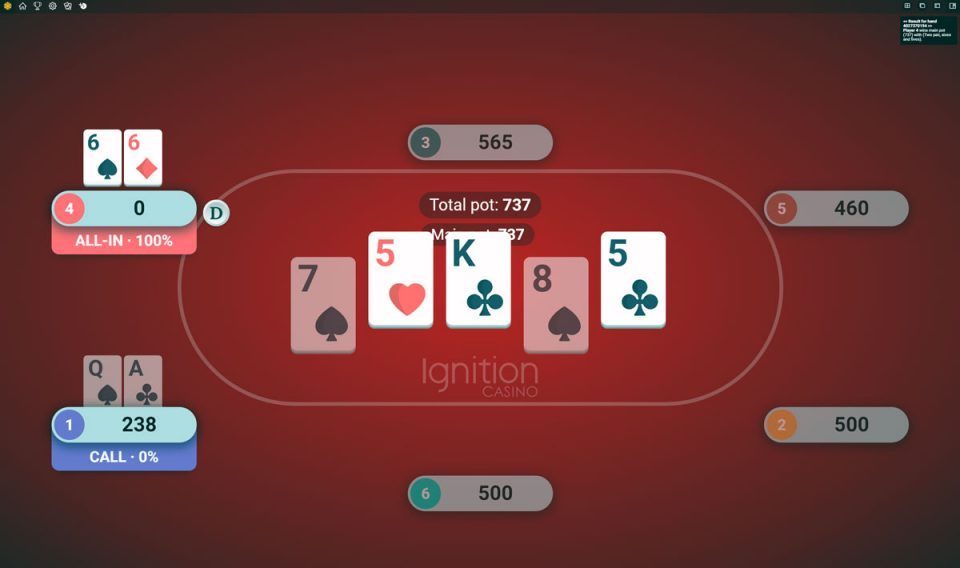Collusion Poker Meaning
What Does It Mean in Poker? Collusion is cheating involving two or more players working together. Collusion can mean any illegal cheating between 2 or more players. Common types of collusion include Chip Dumping, stacking a Cold Deck, and communicating hands using signals or in another language.
- Online Poker Tournaments ♥ Sit n Go Tournament Tips ♥ Poker Freerolls. Collusion - A cheating conspiracy between two or more players. When two or more people engage in coordinated cheating in a poker game, it is called collusion. Collusion takes many forms, and it runs the gamut from relatively benign to malignant.
- Collusion is the act of cheating at online poker by sharing information in order to gain an unsportsmanlike advantage over your opponents. Collusion is defined differently by different online poker sites, but generally, the following activities are against the rules.
- The Collusion Strategy of Cheaters in Poker Cheaters in the world of poker have come up with several hard-to-notice cheating strategies that helped them propel in these games. One of the biggest problems of casinos and gambling establishments worldwide is collusion.

| Look up collude or collusion in Wiktionary, the free dictionary. |
| Competition law |
|---|
| Basic concepts |
|
| Anti-competitive practices |
|
| Enforcement authorities and organizations |
Collusion is a deceitful agreement or secret cooperation between two or more parties to limit open competition by deceiving, misleading or defrauding others of their legal right. Collusion is not always considered illegal. It can be used to attain objectives forbidden by law; for example, by defrauding or gaining an unfair market advantage. It is an agreement among firms or individuals to divide a market, set prices, limit production or limit opportunities.[1]It can involve 'unions, wage fixing, kickbacks, or misrepresenting the independence of the relationship between the colluding parties'.[2] In legal terms, all acts effected by collusion are considered void.[3]
Definition[edit]
Collusion Economics
In the study of economics and market competition, collusion takes place within an industry when rival companies cooperate for their mutual benefit. Collusion often takes place within an oligopolymarket structure, where there are few firms and agreements have significant impacts on the entire market or industry. To differentiate from a cartel, collusive agreements between parties may not be explicit; however, the implications of cartels and collusion are the same.[4]
Collusion which is covert is known as tacit collusion, and is considered legal. Adam Smith in the Wealth of Nations explains that since the masters (business owners) are fewer in numbers, it is easier to collude to serve common interests among those involved, such as maintaining low wages, whilst it is difficult for the labour to coordinate to protect their own interests due to their vast numbers. Hence, business owners have a bigger advantage over the working class. Nevertheless, according to Adam Smith, the public rarely hear about coordination and collaborations that occur between business owners as it takes place under informal settings.[5]
Variations[edit]
According to neoclassical price-determination theory and game theory, the independence of suppliers forces prices to their minimum, increasing efficiency and decreasing the price-determining ability of each individual firm.[6]However if all firms collude to increase prices, loss of sales will be minimized, as consumers lack alternative choices at lower prices and must decide between what is available. This benefits the colluding firms, as they generate more sales, at the cost of efficiency to society.[7]
One variation of this traditional theory is the theory of kinked demand. Firms face a kinked demand curve if, when one firm decreases its price, other firms are expected to follow suit in order to maintain sales. When one firm increases its price, its rivals are unlikely to follow, as they would lose the sales' gains that they would otherwise receive by holding prices at the previous level. Kinked demand potentially fosters supra-competitive prices because any one firm would receive a reduced benefit from cutting price, as opposed to the benefits accruing under neoclassical theory and certain game-theoretic models such as Bertrand competition.[8]

Collusion may also occur in auction markets, where independent firms coordinate their bids (bid rigging). [9]
Antecedents[edit]

Scholars in economics and management have tried to identify factors explaining why some firms are more or less likely to be involved in collusion. Some have noted the role of the regulatory environment[10] and the existence of leniency programs.[11] Others, drawing upon the literature in criminology and misconduct, have suggested that firms conduct a costs/benefits analysis to assess their participation in collusion.[12]
Indicators[edit]
Practices that suggest possible collusion may include one or more actions such as:
- Uniform prices and setting of an unjustified high or an unjustified low price
- Kickbacks and blanket referral agreements between competing businesses
- Dividing territories and market allocation
- Tying agreements and anticompetitive Product bundling (although, not all product bundling is anticompetitive)
- Refusal to deal and Exclusive dealing
Examples[edit]
Collusion is illegal in the United States, Canada and most of the EU due to antitrust laws, but implicit collusion in the form of price leadership and tacit understandings still takes place. Several examples of collusion in the United States include:
- Market division and price-fixing among manufacturers of heavy electrical equipment in the 1960s, including General Electric.[13]
- An attempt by Major League Baseball owners to restrict players' salaries in the mid-1980s.
- The sharing of potential contract terms by NBA free agents in an effort to help a targeted franchise circumvent the salary cap.
- Price fixing within food manufacturers providing cafeteria food to schools and the military in 1993.
- Market division and output determination of livestock feed additive, called lysine, by companies in the US, Japan and South Korea in 1996, Archer Daniels Midland being the most notable of these.[14]
- Chip dumping in poker[15] or any other card game played for money.
- Ben and Jerry's and Häagen-Dazs collusion of products in 2013: Ben and Jerry's makes chunkier flavors with more treats in them, while Häagen-Dazs sticks to smoother flavors. [16]
- The Google and Apple against employee poaching collusion case in 2015, in which it was revealed that both companies agreed not to hire employees from one another in order to halt the rise of wages.[17]

In the EU:
- The illegal collusion between the giant German automakers BMW, Daimler and Volkswagen, discovered by the European Commission in 2019, to hinder technological progress in improving the quality of vehicle emissions in order to reduce the cost of production and maximize profits.[18]
There are many ways that implicit collusion tends to develop:
Dynamic Collusion Meaning
- The practice of stock analyst conference calls and meetings of industry participants almost necessarily results in tremendous amounts of strategic and price transparency. This allows each firm to see how and why every other firm is pricing their products.
- If the practice of the industry causes more complicated pricing, which is hard for the consumer to understand (such as risk-based pricing, hidden taxes and fees in the wireless industry, negotiable pricing), this can cause competition based on price to be meaningless (because it would be too complicated to explain to the customer in a short advertisement). This causes industries to have essentially the same prices and compete on advertising and image, something theoretically as damaging to consumers as normal price fixing.[citation needed]
Barriers[edit]
There can be significant barriers to collusion. In any given industry, these may include:
- The number of firms: As the number of firms in an industry increases, it is more difficult to successfully organize, collude and communicate.
- Cost and demand differences between firms: If costs vary significantly between firms, it may be impossible to establish a price at which to fix output.
- Cheating: There is considerable incentive to cheat on collusion agreements; although lowering prices might trigger price wars, in the short term the defecting firm may gain considerably. This phenomenon is frequently referred to as 'chiseling'.
- Potential entry: New firms may enter the industry, establishing a new baseline price and eliminating collusion (though anti-dumping laws and tariffs can prevent foreign companies entering the market).
- Economic recession: An increase in average total cost or a decrease in revenue provides incentive to compete with rival firms in order to secure a larger market share and increased demand.
- Anti-collusion legal framework and collusive lawsuit.
See also[edit]
References[edit]
General references[edit]
- Vives, X. (1999) Oligopoly pricing, MIT Press, Cambridge MA (readable; suitable for advanced undergraduates.)
- Tirole, J. (1988) The Theory of Industrial Organization, MIT Press, Cambridge MA (An organized introduction to industrial organization)
- Tirole, J. (1986), 'Hierarchies and Bureaucracies', Journal of Law Economics and Organization, vol. 2, pp. 181–214.
- Tirole, J. (1992), 'Collusion and the Theory of Organizations', Advances in Economic Theory: Proceedings of the Sixth World Congress of the Econometric Society, ed by J.-J. Laffont. Cambridge: Cambridge University Press, vol.2:151-206.
Inline citations[edit]

- ^O'Sullivan, Arthur; Sheffrin, Steven M. (2003). Economics: Principles in Action. Upper Saddle River, New Jersey 07458: Pearson Prentice Hall. pp. 171. ISBN0-13-063085-3.CS1 maint: location (link)
- ^Collusion Law & Legal Definition
- ^Collusion [1]Archived 2008-01-09 at the Wayback Machine. ArchivedArchived 2017-03-21 at the Wayback Machine 2009-10-31.
- ^'OECD Glossary of Statistical Terms - Collusion Definition'. stats.oecd.org. Retrieved 2020-11-01.
- ^'A Critique of Political Economy'(PDF).
- ^Kalai, Ehud; Satterthwaite, Mark A. (1994), Gilles, Robert P.; Ruys, Pieter H. M. (eds.), 'The Kinked Demand Curve, Facilitating Practices, and Oligopolistic Coordination', Imperfections and Behavior in Economic Organizations, Theory and Decision Library, Dordrecht: Springer Netherlands, pp. 15–38, doi:10.1007/978-94-011-1370-0_2, ISBN978-94-011-1370-0, retrieved 2020-11-01
- ^'OECD Glossary of Statistical Terms - Collusion Definition'. stats.oecd.org. Retrieved 2020-11-01.
- ^Kalai, Ehud; Satterthwaite, Mark A. (1994), Gilles, Robert P.; Ruys, Pieter H. M. (eds.), 'The Kinked Demand Curve, Facilitating Practices, and Oligopolistic Coordination', Imperfections and Behavior in Economic Organizations, Theory and Decision Library, Dordrecht: Springer Netherlands, pp. 15–38, doi:10.1007/978-94-011-1370-0_2, ISBN978-94-011-1370-0, retrieved 2020-11-01
- ^Conley, Timothy; Decarolis, Francesco (2016). 'Detecting Bidders Groups in Collusive Auctions'. American Economic Journal: Microeconomics. 8 (2): 1–38. doi:10.1257/mic.20130254.
- ^Morgan, Eleanor J. (2009). 'Controlling cartels – Implications of the EU policy reforms'. European Management Journal. 27 (1): 1–12. doi:10.1016/j.emj.2008.04.006. ISSN0263-2373.
- ^Brenner, Steffen (2009). 'An empirical study of the European corporate leniency program'. International Journal of Industrial Organization. 27 (6): 639–645. doi:10.1016/j.ijindorg.2009.02.007. ISSN0167-7187.
- ^Bertrand, Olivier; Lumineau, Fabrice; Fedorova, Evgenia (2014). 'The Supportive Factors of Firms' Collusive Behavior: Empirical Evidence from Cartels in the European Union'. Organization Studies. 35 (6): 881–908. doi:10.1177/0170840613515471. ISSN0170-8406. S2CID54605004.
- ^Salinger, Lawrence M. (2005). Encyclopedia of white-collar & corporate crime. ISBN9780761930044.
- ^Hunter-Gault, Charlayne (October 15, 1996). 'ADM: Who's Next?'. MacNeil/Lehrer Newshour (PBS). https://www.pbs.org/newshour/bb/business/october96/adm_10-15.html. Retrieved on 2007-10-17.
- ^T. Hayes, 'Collusion Strategy and Analysis for Texas Hold'em', 2017
- ^Sullivan, Christopher John. Three Essays on Product Collusion. Diss. University of Michigan, 2016. https://deepblue.lib.umich.edu/bitstream/handle/2027.42/138544/sullivcj_1.pdf?sequence=1&isAllowed=y
- ^'A Critique of Political Economy'.
- ^'European Commission finds German automakers illegally colluded on emissions technology'.